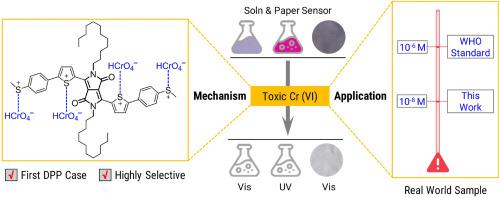当前位置:
X-MOL 学术
›
Anal. Chim. Acta
›
论文详情
Our official English website, www.x-mol.net, welcomes your feedback! (Note: you will need to create a separate account there.)
Rapidly and simply detecting Cr (VI) in aqueous media via a diketopyrrolopyrrole-based chemosensor with both high selectivity and low LOD
Analytica Chimica Acta ( IF 5.7 ) Pub Date : 2024-06-10 , DOI: 10.1016/j.aca.2024.342861 Mahnaz D. Gholami , Fatimah M. Alzubaidi , Qian Liu , Emad L. Izake , Prashant Sonar
Analytica Chimica Acta ( IF 5.7 ) Pub Date : 2024-06-10 , DOI: 10.1016/j.aca.2024.342861 Mahnaz D. Gholami , Fatimah M. Alzubaidi , Qian Liu , Emad L. Izake , Prashant Sonar

|
The high toxicity of hexavalent chromium [Cr (VI)] could not only cause harmful effects on humans, including carcinogenicity, respiratory issues, genetic damage, and skin irritation, but also contaminate drinking water sources, aquatic ecosystems, and soil, impairing the reproductive capacity, growth, and survival of organisms. Due to these harmful effects, detecting toxic Cr (VI) is of great significance. However, the rapid, simple, and efficient detection at a low Cr (VI) concentration is extremely challenging, especially in an acidic condition (existing as HCrO) due to its low adsorption free energy. A diketopyrrolopyrrole-based small molecule (DPPT-PhSMe) is designed and characterized to act as a chemosensor, which allows a high selectivity to Cr (VI) at an acidic condition with a low limit of detection to 10 M that is two orders of magnitude lower than the cut of limit (1 μM) recommended by World Health Organization (WHO). Mechanism study indicates that the rich sulfur atoms enhance the affinity to HCrO. Combining with favorable features of diketopyrrolopyrrole, DPPT-PhSMe not only allows dual-mode detection (colorimetric and spectroscopic) to Cr (VI), but also enables disposable paper-based sensor for naked-eye detection to Cr (VI) from fully aqueous media. The investigation of DPPT-PhSMe chemosensor for the quantification of Cr (VI) in real life samples demonstrates a high reliability and accuracy with an average percentage recovery of 102.1 % ± 4 (n = 3). DPPT-PhSMe represents the first diketopyrrolopyrrole-derived chemosensor for efficient detection to toxic Cr (VI), not only providing a targeted solution to the bottleneck of Cr (VI) detection in acidic conditions (existing as HCrO) caused by its low adsorption free energy, but also opening a new scenario for simple, selective, and efficient Cr (VI) detection with conjugated dye molecules.
中文翻译:

通过具有高选择性和低 LOD 的二酮吡咯并吡咯化学传感器快速、简单地检测水介质中的 Cr (VI)
六价铬[Cr(VI)]的高毒性不仅会对人类造成有害影响,包括致癌、呼吸道问题、遗传损伤和皮肤刺激,还会污染饮用水源、水生生态系统和土壤,损害生殖能力。生物体的能力、生长和生存。由于这些有害影响,检测有毒的Cr(VI)具有重要意义。然而,在低 Cr (VI) 浓度下快速、简单、高效的检测极具挑战性,特别是在酸性条件下(以 HCrO 形式存在),因为其吸附自由能较低。基于二酮吡咯并吡咯的小分子 (DPPT-PhSMe) 被设计和表征为化学传感器,可在酸性条件下对 Cr (VI) 具有高选择性,检测限低至 10 M(两个数量级)低于世界卫生组织 (WHO) 建议的限值 (1 μM)。机理研究表明,丰富的硫原子增强了与HCrO的亲和力。结合二酮吡咯并吡咯的有利特性,DPPT-PhSMe 不仅可以对 Cr (VI) 进行双模式检测(比色和光谱),而且还可以使用一次性纸基传感器对全水介质中的 Cr (VI) 进行肉眼检测。 DPPT-PhSMe 化学传感器对现实样品中 Cr (VI) 定量的研究表明,其具有很高的可靠性和准确性,平均回收百分比为 102.1% ± 4 (n = 3)。 DPPT-PhSMe代表了第一个用于高效检测有毒Cr(VI)的二酮吡咯并吡咯化学传感器,不仅为酸性条件下Cr(VI)检测(以HCrO形式存在)因吸附自由能低而造成的瓶颈提供了针对性的解决方案,同时也为利用共轭染料分子进行简单、选择性和高效的 Cr (VI) 检测开辟了新的前景。
更新日期:2024-06-10
中文翻译:

通过具有高选择性和低 LOD 的二酮吡咯并吡咯化学传感器快速、简单地检测水介质中的 Cr (VI)
六价铬[Cr(VI)]的高毒性不仅会对人类造成有害影响,包括致癌、呼吸道问题、遗传损伤和皮肤刺激,还会污染饮用水源、水生生态系统和土壤,损害生殖能力。生物体的能力、生长和生存。由于这些有害影响,检测有毒的Cr(VI)具有重要意义。然而,在低 Cr (VI) 浓度下快速、简单、高效的检测极具挑战性,特别是在酸性条件下(以 HCrO 形式存在),因为其吸附自由能较低。基于二酮吡咯并吡咯的小分子 (DPPT-PhSMe) 被设计和表征为化学传感器,可在酸性条件下对 Cr (VI) 具有高选择性,检测限低至 10 M(两个数量级)低于世界卫生组织 (WHO) 建议的限值 (1 μM)。机理研究表明,丰富的硫原子增强了与HCrO的亲和力。结合二酮吡咯并吡咯的有利特性,DPPT-PhSMe 不仅可以对 Cr (VI) 进行双模式检测(比色和光谱),而且还可以使用一次性纸基传感器对全水介质中的 Cr (VI) 进行肉眼检测。 DPPT-PhSMe 化学传感器对现实样品中 Cr (VI) 定量的研究表明,其具有很高的可靠性和准确性,平均回收百分比为 102.1% ± 4 (n = 3)。 DPPT-PhSMe代表了第一个用于高效检测有毒Cr(VI)的二酮吡咯并吡咯化学传感器,不仅为酸性条件下Cr(VI)检测(以HCrO形式存在)因吸附自由能低而造成的瓶颈提供了针对性的解决方案,同时也为利用共轭染料分子进行简单、选择性和高效的 Cr (VI) 检测开辟了新的前景。






































 京公网安备 11010802027423号
京公网安备 11010802027423号